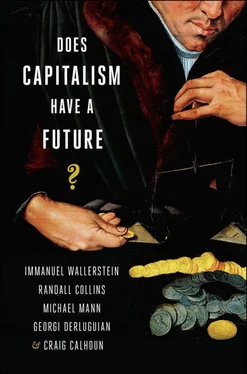Capitalism has flourished, and secured widespread legitimacy, on the basis of institutions and social relations that have been damaged in recent decades; its renewal will depend on their renewal. This is partly a matter of providing for legitimacy, social solidarity, and social support. It is also a matter of dealing with the fact that capitalist growth is at the same time a matter of urbanization, resource demands, environmental degradation, migration, and a host of other issues—not simply investment, production and profit. The capacity to deal with these comes not just from markets but governments and indeed a wide range of social institutions. As Karl Polanyi argued in the midst of twentieth-century depression and war, looking back at the nineteenth century as well as forward, unbridled capitalist development always undermines the social conditions of its own survival as well as the greater good; efforts to build new institutional supports can both stabilize the capitalist system and underpin more effective sharing of the benefits of capitalist growth.
An implicit social contract underwrites the legitimacy not just of capitalist enterprise but also of the states that provide for its continuity: citizens tolerate inequality and the externalization of long-term costs in return for growth. Today’s high-growth countries in Asia, Latin America, and Africa all face serious challenges producing balance enough in their growth patterns to maintain national cohesion and investment in the conditions of future growth. They will not obviously be able to sustain recent growth rates, especially in a low-growth global economy, and absent such growth they will face both bursting speculative bubbles and citizen discontent.
Europe and the United States face the same challenges without the benefit of optimism or growth. Anxiety about the long absence of economic growth and manifest political weakness dealing with this is palpable, but so far has not produced a social movement response capable of truly shaping the likely outcomes. Popular response to economic crisis and weak government legitimacy has come largely in right-wing and often xenophobic agitations. Government response in Europe is a debilitating effort to restore state fiscal balances by austerity programs while preserving the capital of those who were the primary beneficiaries of financialization and the precipitators of crisis. The United States has done more to stimulate renewed growth, but suffers from political deadlocks as well as the same determination that costs should be borne by taxpayers at large more than by financial institutions or their investors.
During eras of sustained and substantial growth, especially following the Second World War, capitalism generated employment and improving pay. At the same time, economic growth underwrote expansions in health care, education, transportation, and other benefits in which citizens widely shared on the basis of progressive taxation and government investments. Now citizens doubt their children will enjoy greater prosperity or opportunity than they do. The desire of citizens in rich countries to get richer is confronted by their countries’ need to remain internationally competitive (not just for trade, but to command the allegiance of elites and corporations that may flee high tax regimes). There are good reasons to expect growth rates in the old rich capitalist core countries to lag global growth so that even if they remain rich, improvements will be reduced absent major structural reform. At the same time, institutional structures that long ensured the overall legitimacy of capitalism have been eroded since the 1970s and more sharply in the context of financial and fiscal crisis.
The term “neoliberalism” is used to refer to a package of policies that sought simultaneously to reduce government costs and active participation in economic activity and to reduce government regulation of capitalist markets. This post-1970s liberalism owed much to nineteenth-century liberalism. A central difference is that the later version sought to unravel a host of social protections and economic arrangements put in place as part of mature capitalism. Its major targets were institutional arrangements put in place in response to the Great Depression and in the long postwar boom. But the link to nineteenth-century liberalism is instructive, for it reminds us to recognize that the tension between pursuit of “unfettered” capitalism and the effort to compensate for capitalism’s limits and excesses is an old one. In the nineteenth century, liberals often sought to dismantle traditional institutions that got in the way of capitalist profits as well as to limit new ones. And this is an issue throughout the developing world today.
In China, for example, the development of highly dynamic capitalism is in tension with long-standing local community structures as well as alternative institutions put in place during the communist era—like the danwei , which made a “work unit” the central provider of housing, health care, and employment (with certain similarities to paternalistic company towns in an earlier phase of Western capitalist development). Workers taking new jobs, especially those migrating to new jobs in fast-growing urban regions, are stripped of both older forms of social capital in their communities of origin and the institutional provisions once offered by the danwei . They make new ways of life in cities, doing well to the extent that they have money to purchase market substitutes for the older forms of provision and struggling more when they don’t. Sometimes they create new social institutions for themselves, much as migrants to cities such as Shanghai a generation ago created native place and clanship associations. Often they live somewhat marginal existences, trying to save money either to send home or to bring families. The government attempts to regulate this process, for example using the houkou system to restrict unauthorized migrants’ access to urban institutions like schools. The very existence of the restriction is evidence of the institutional deficit as much as a tool of social control.
As China develops further in a capitalist direction, however, it needs stronger institutions. The government is indeed expanding education and restructuring health care, not least through introducing a new system of primary care. There are anxieties about what institutions will provide care for the elderly in a rapidly aging society (with family provision undercut not just by changing attitudes but by labor migration and the one-child family policy). One may only speculate on what may develop to provide unemployment protection or social services. The new institutions could be charitable undertakings or mutual benefit societies, though so far the government has been reluctant to allow either much autonomy. It seems clearly to be following a capitalist path but it is unclear how much this will involve a replication of Western institutions, an emulation of the Western neoliberalism that tries to minimize such institutions, or some variety of state capitalism (“with Chinese characteristics”).
State capitalism has been an exception during the last 450 years, but one possible transformation of capitalism would be for it to grow more common. Arguably Soviet communism already involved something like state capitalism. Certainly fascism did. Where governments today use reactionary nationalism to shore up their legitimacy, state capitalism seems more likely. The key point is that future capitalism need not be an extension of the “liberal capitalism” dominant in the last two centuries of Western history. The widely remarked link between capitalism and liberal democracy may turn out to have been only one way of relating capitalism to politics, shaped by particular historical conditions and struggles.
Читать дальше












